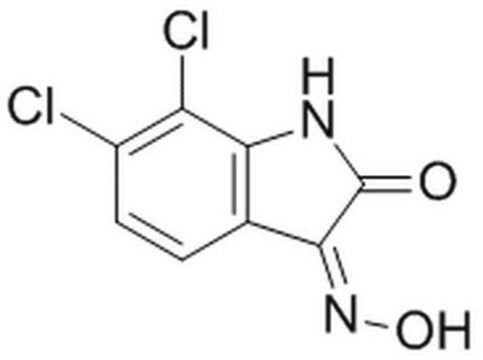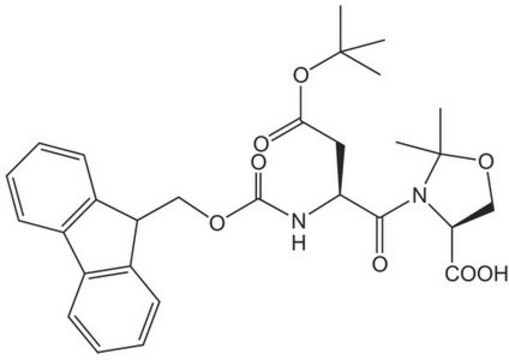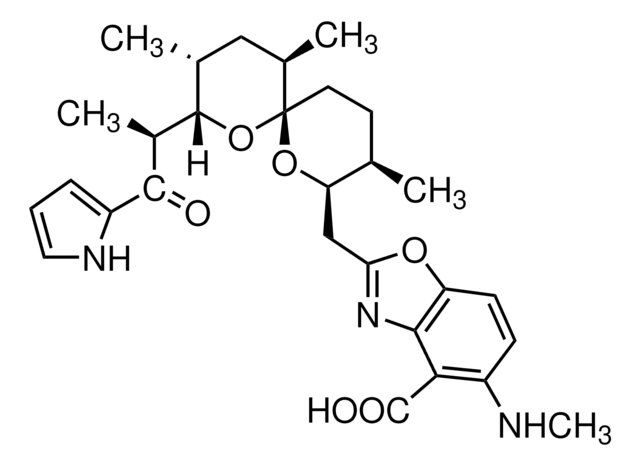SML2082
Scrambled 10Panx1 trifluoroacetate salt
≥98% (HPLC)
Synonim(y):
10PanxSCR TFA, FSVYWAQADR TFA, L-phenylalanyl-L-seryl-L-valyl-L-tyrosyl-L-tryptophyl-L-alanyl-L-glutaminyl-L-alanyl-L-a-aspartyl-L-arginine TFA, Phe-Ser-Val-Tyr-Trp-Ala-Gln-Ala-Asp-Arg TFA, SCPanx, TFA, Scrambled 10Panx TFA
About This Item
Polecane produkty
Próba
≥98% (HPLC)
Formularz
film (Colorless)
kolor
white to off-white
Warunki transportu
wet ice
temp. przechowywania
−20°C
ciąg SMILES
[nH]1c2c(c(c1)CC(NC(=O)C(NC(=O)C(NC(=O)C(NC(=O)C(N)Cc4ccccc4)CO)C(C)C)Cc3ccc(cc3)O)C(=O)NC(C)C(=O)NC(CCC(=O)N)C(=O)NC(C)C(=O)NC(CC(=O)O)C(=O)NC(CCCN=C(N)N)C(=O)O)cccc2
InChI
1S/C58H79N15O16/c1-29(2)47(73-55(86)44(28-74)72-50(81)37(59)23-32-11-6-5-7-12-32)56(87)71-41(24-33-16-18-35(75)19-17-33)53(84)70-42(25-34-27-64-38-14-9-8-13-36(34)38)52(83)66-30(3)48(79)67-39(20-21-45(60)76)51(82)65-31(4)49(80)69-43(26-46(77)78)54(85)68-40(57(88)89)15-10-22-63-58(61)62/h5-9,11-14,16-19,27,29-31,37,39-44,47,64,74-75H,10,15,20-26,28,59H2,1-4H3,(H2,60,76)(H,65,82)(H,66,83)(H,67,79)(H,68,85)(H,69,80)(H,70,84)(H,71,87)(H,72,81)(H,73,86)(H,77,78)(H,88,89)(H4,61,62,63)
Klucz InChI
VNQGVHMGXBRHRA-UHFFFAOYSA-N
Działania biochem./fizjol.
Kod klasy składowania
11 - Combustible Solids
Klasa zagrożenia wodnego (WGK)
WGK 3
Temperatura zapłonu (°F)
Not applicable
Temperatura zapłonu (°C)
Not applicable
Wybierz jedną z najnowszych wersji:
Certyfikaty analizy (CoA)
It looks like we've run into a problem, but you can still download Certificates of Analysis from our Dokumenty section.
Proszę o kontakt, jeśli potrzebna jest pomoc Obsługa Klienta
Masz już ten produkt?
Dokumenty związane z niedawno zakupionymi produktami zostały zamieszczone w Bibliotece dokumentów.
Nasz zespół naukowców ma doświadczenie we wszystkich obszarach badań, w tym w naukach przyrodniczych, materiałoznawstwie, syntezie chemicznej, chromatografii, analityce i wielu innych dziedzinach.
Skontaktuj się z zespołem ds. pomocy technicznej








